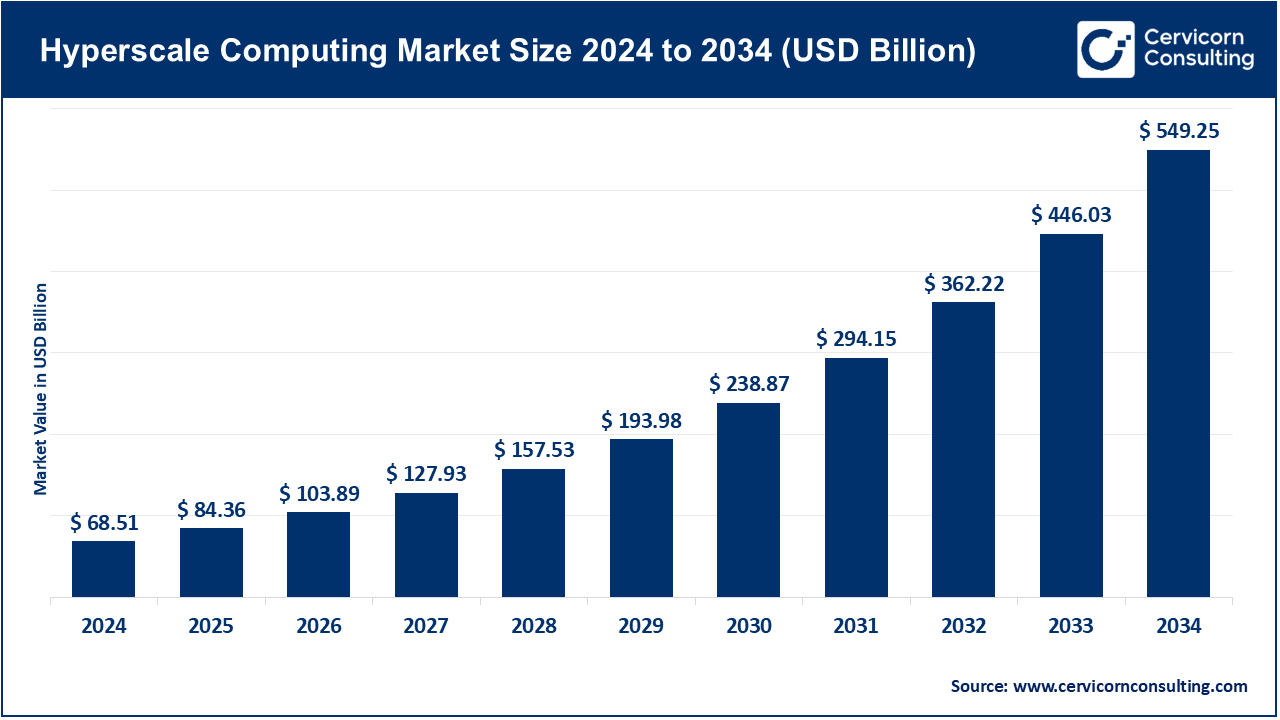Hyperscale Computing Market Size
The global hyperscale computing market was valued at USD 68.51 billion in 2024 and is projected to reach USD 549.25 billion by 2034, growing at a CAGR of 23.14% from 2025 to 2034.
What is the Hyperscale Computing Market?
Definition and Scope
The hyperscale computing market encompasses the infrastructure, technologies, and services that enable organizations to manage and process vast amounts of data efficiently. This includes large-scale data centers, advanced networking, storage solutions, and cloud services designed to handle the demands of big data, artificial intelligence (AI), and Internet of Things (IoT) applications.
Significance
Hyperscale computing is pivotal for supporting the digital transformation of industries, facilitating the growth of cloud computing, and enabling real-time data processing and analytics. It underpins the operations of major technology companies and service providers, ensuring scalability, reliability, and performance.
Get a Free Sample: https://www.cervicornconsulting.com/sample/2708
Market Trends
-
AI and Machine Learning Integration
The increasing adoption of AI and machine learning technologies is driving the demand for hyperscale computing. These applications require substantial computational power, which hyperscale infrastructures can provide efficiently. For instance, AI model training and inference tasks benefit from the parallel processing capabilities of large-scale data centers.
-
Edge Computing Expansion
To reduce latency and bandwidth usage, there’s a growing trend towards edge computing, where data processing occurs closer to the data source. Hyperscale providers are expanding their infrastructure to include edge locations, enabling faster data processing for applications like autonomous vehicles and real-time analytics.
-
Sustainability Initiatives
With increasing energy consumption concerns, hyperscale data centers are adopting sustainable practices. This includes utilizing renewable energy sources, implementing energy-efficient cooling systems, and designing facilities with low environmental impact to meet regulatory requirements and corporate sustainability goals.
Market Dynamics
Drivers:
-
Data Explosion: The exponential growth of data from various sources necessitates scalable computing solutions to store, process, and analyze this information effectively.
-
Cloud Adoption: The shift towards cloud services requires robust infrastructure, propelling the demand for hyperscale computing solutions.
-
Technological Advancements: Innovations in hardware and software technologies enhance the capabilities and efficiency of hyperscale computing systems.
Restraints:
-
High Capital Expenditure: The significant investment required for building and maintaining hyperscale data centers can be a barrier for some organizations.
-
Regulatory Challenges: Compliance with data protection and privacy regulations can complicate the deployment and operation of hyperscale infrastructures, especially across different jurisdictions.
Opportunities:
-
AI and IoT Growth: The proliferation of AI and IoT applications presents opportunities for hyperscale providers to offer specialized solutions tailored to these technologies.
-
Emerging Markets: Expanding digitalization in developing regions opens new avenues for hyperscale computing services.
Challenges:
-
Energy Consumption: Managing the substantial energy requirements of hyperscale data centers while minimizing environmental impact remains a critical challenge.
-
Infrastructure Complexity: Designing and maintaining complex hyperscale systems require specialized expertise and can lead to operational challenges.
Regional Analysis
-
North America: Dominates the hyperscale computing market, driven by the presence of major technology companies and advanced infrastructure.
-
Asia-Pacific: Experiences rapid growth due to increasing digitalization, government initiatives, and the expansion of cloud services.
-
Europe: Focuses on data sovereignty and compliance with regulations like GDPR, influencing the deployment of hyperscale data centers.
-
Latin America and Middle East & Africa: Emerging markets with growing demand for scalable computing solutions, though infrastructure development is still underway.
Recent Developments
-
Strategic Investments: Companies are investing in expanding their hyperscale data center capabilities to meet the growing demand for cloud services and AI applications.
-
Partnerships and Collaborations: Alliances between technology providers and energy companies aim to enhance the sustainability and efficiency of hyperscale infrastructures.
-
Regulatory Adaptations: Governments are updating policies to address the challenges posed by the rapid growth of hyperscale computing, focusing on data privacy, energy consumption, and infrastructure development.
For more detailed insights and data, you can visit the original source: Cervicorn Consulting
Read: Dental Services Market Analysis and Regional Insights by 2034

